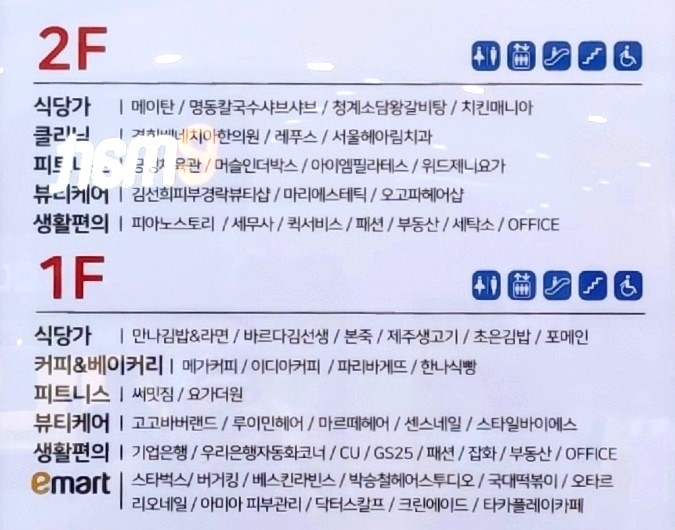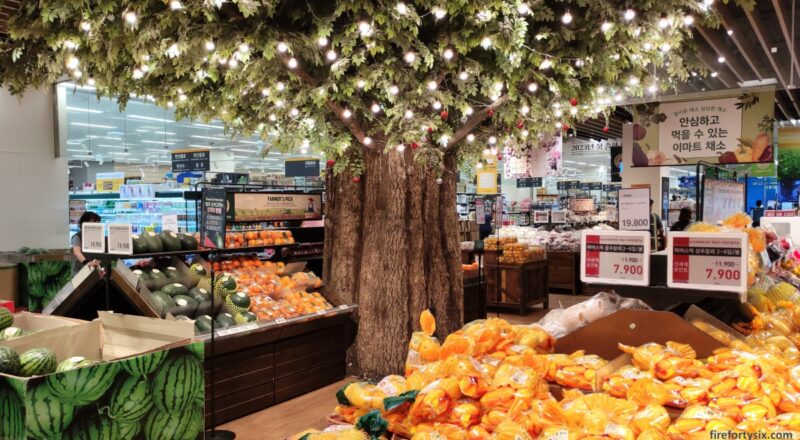It has become somewhat of a ritual for us to spend the second last day of our overseas holidays in a large supermarket.
Whether it’s the Takashimaya Times Square in Shinjuku, the Shinkong Mitsukoshi opposite Taipei Station, the Big C near CentralWorld Bangkok or Lotte Mart at Seoul Station.
We don’t usually leave souvenir shopping to the very last minute, but in this case, it was necessary. Because the souvenirs in question involve fresh and perishable local produce.
Like the Japanese daikon that The Wife made me lug home at the end of our previous trip to Tokyo.
Before you ask, yes, they sell those in Singapore as well. But I suppose there’s something about personally escorting a radish across 5,300 kilometres that makes it extra tasty.

Location
To mark the end of our recent Seoul vacation, I wanted to find somewhere new, instead of our usual Lotte Mart. And that place was the Emart Cheonggyecheon flagship store, a short bus ride away from Gyeongdong Market.
Our bus stopped just outside the building, and despite being a flagship store, it looked more like a regular neighbourhood place for locals to do their grocery shopping.
There were no tourists in sight, except for us of course. I like to believe that supermarkets are tourist attractions in their own right, but this particular Emart was clearly not a good example.

Store Directory
We didn’t recognise any other famous brands listed on the directory, besides the omnipresent Paris Baguette.
Which, in case you’re wondering, is a local bakery chain that didn’t originate from France. They do sell baguettes though, as well as other breads and pastries.




Fruits
After taking the escalator down to B2 and walking through the Emart entrance, we were greeted by a big tree decorated with bright fairy lights.

Underneath it were all kinds of fresh fruits, particularly the petite yellow-striped Korean cham-oe (참외) melons. We had always wanted to try them and at ₩7,900 for a bag, it was an opportunity not to be missed.
Likewise for the bright red Korean ttalgi (딸기), which were aggressively discounted from 30-50%. A box of 50 strawberries was going for only ₩11,800, or ₩236 (S$0.24) per piece.
The packaging looked like it was sturdy enough to survive the 6 hour+ flight back to Singapore. As long as we carefully hand carried it home, and didn’t stack anything on top.


Vegetables
Equally enticing was the vegetable section, filled with shelf-after-shelf of fresh kkaennip leaves. If The Wife hadn’t already bought 100 of them at Gyeongdong Market, she definitely would have grabbed several packets.
While standing in front of an entire display stand filled with multi-coloured tomatoes, she lingered for a while, trying to figure out: (i) if she should get some, and (ii) which ones to buy.


Eventually, a pack of deep purple tomatoes ended up in the shopping basket. At first glance, I almost mistook them for juicy globes of grapes.
In addition to the fresh vegetables, there were also pre-processed packs of uniquely Korean root vegetables like deodeok (더덕) and doraji (도라지). The latter is known as bellflower root in English, and makes for a really nice kimchi.


Meat
When I walked past the beef section, I was especially curious to compare the Hanwoo (한우) prices vs what we paid for at Majang meat market. There was a tray of 1++(7) Hanwoo which was going for ₩14,900 per 100gm.


It had less marbling and didn’t look as drool-worthy as the 1++(9) version that we had bought for ₩17,000 per 100gm, but the price was definitely attractive.
On the cheaper end of the protein spectrum, there were entire fridges stuffed with frozen pre-sliced beef and pork. They looked perfect for a BBQ at home, paired with copious amounts of somaek (소맥).


Seafood
The seafood section was equally enticing, starting with live tanks of king and snow crabs. I had initially planned to visit Noryangjin Market for steamed crab, but chickened out because I was afraid of unexpected sticker shock.
Looking at the prices posted in Emart Cheonggyecheon, I’m relieved we decided to pass.

The chillers beside it were filled with various types of shellfish, crustaceans, fish and even whole octopuses. Prices displayed were reassuringly more wallet-friendly.




Prepared Food
Besides the wide variety of fresh produce, there was also a large selection of convenience food. Including the ever-popular frozen mandu (만두) from all the major brands, as well as meal kits that rose in popularity during the pandemic.


I spotted one of my favourite banchan, raw marinated squid, in ready-to-go packs. Tempting as it looked, I didn’t have the confidence that they could be safely transported home.

We also came across an entire area offering numerous takeaway choices. Fried chicken and kimbap were a given, as were freshly-sliced hwe 회 (i.e. sashimi) and spicy dakbal 닭발 (i.e. chicken feet).




Instant Coffee
I had already bought two bags of freshly-roasted beans from the Blue Bottle Coffee in Samcheongdong a few days ago, but the shelves of Kanu caught my attention.


They must have paid a small fortune to get Gong Yoo as their spokesperson, but it must have paid huge dividends for them.
Coffee Prince is one of my all-time favourite K-dramas, and if Kanu is good enough for him, it’s surely must be good enough for me. Yes, I admit, I’m a sucker for marketing.
Our Souvenirs
I got a 30 stick pack of the Kanu Maxim mild Americano, with each sachet containing 1.6gm of freeze-dried black coffee.
The box got slightly crushed in the luggage, but managed to make it home in one piece. After drinking several cups, it’s now my favourite instant coffee, displacing the AGF Blendy from Japan.

As for the most fragile souvenir that we bought, I’m happy to report that the strawberries made it back relatively unscathed.
Some of the fruits weren’t in pristine condition when we opened the box, but that didn’t affect their flavour. They were the sweetest and juiciest strawberries we’ve ever had. Pretty amazing given that they only cost S$0.24 each.


The purple tomatoes were tossed with the kkaennip leaves in a light vinaigrette, and made for a light and refreshing salad. I’m sure The Wife regretted not buying more boxes.


As expected, the yellow Korean melons were the most hardy of the lot. They looked exactly the same as when we picked them up at Emart Cheonggyecheon.
I thought that they would be really hard and crunchy, but I was pleasantly surprised.
The flesh was soft and juicy, similar to a honeydew melon, and delightfully sweet. If you’ve never tried them before, do yourself a favour and pick up a bag when you get the chance.


Grocery shopping is probably not on the minds of most tourists. But coming from a non-agricultural country like Singapore, the opportunity to bring home fresh, tasty and cheap produce was simply too good to miss.
